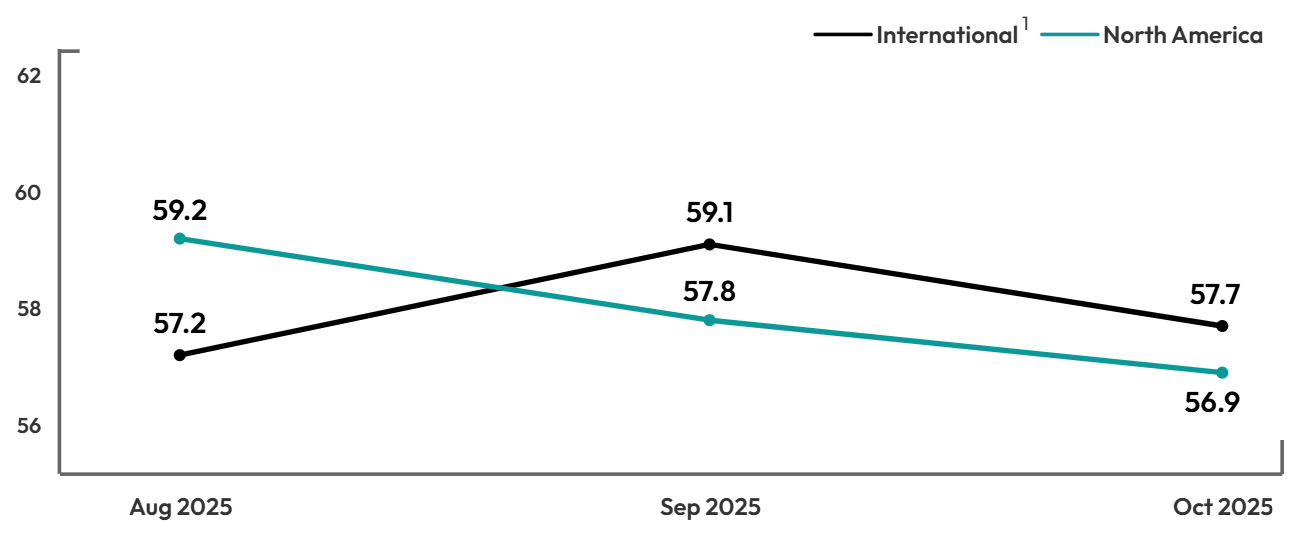Pro-AV Business Index
November remains stable even with seasonal trends

Highlights
The AV Sales Index (AVI-S) for November is 57.2 just about a point increase from November, slightly down from September. Following a robust mid-year peak (60.9), the index has been gradually normalizing, reflecting stabilization after a period of strong growth. This suggests that while demand remains positive, the exceptional growth rates may have tapered as the market adjusts.
Tariffs, political instability, and inflation remain key concerns affecting the AV industry. demands. Businesses are rushing to complete projects before year-end, especially in the education vertical, with seasonal demand fluctuations influencing activity.
The AV Employment Index (AVI-E) remains steady at 56.8, indicating they are still hiring but many companies still face challenges finding qualified workers. The unemployment rate remains stable, the labor market has showed signs of weakening, with unexpected job losses and a decline in hiring activity. The delayed release of official employment data due to the government shutdown added uncertainty to the overall assessment of employment trends for November 2025.
International Outlook
The non-US preliminary November sale index dropped to 54.7 from 56.6 in October, while the employment index increased almost one point to 58.4. The preliminary international sales index increased almost 2 points to 60.8, the international employment index also increased to 53.6. Non-US results are of course subject to country variations. For example, in Europe, the U.K., France, and Spain delivered improved economic results, while Italy and Germany stagnated in November. Likewise in APAC a trio of fundamentals are slowing growth except in pockets such as Southeast Asia. The issues are continued trade tensions, slower consumer spending, and overall challenges to export-driven countries. India, continues to be an exception, showing strong domestic demand and government investment. Large Latin America countries also showed differing results, with Brazil rebounding and Mexico’s economic growth slowing.

1Due to the small sample, the North American and International indexes are based on a 3-month moving average. The November 2025 index is preliminary, based on the average of November rand October 2025 and will be final with December 2025 data in the next report.
1AVIXA®, the Audiovisual and Integrated Experience Association, has published the monthly Pro AV Business Index since September 2016, gauging sales and employment indicators for the pro AV industry. The index is calculated from a monthly survey that tracks trends. Two diffusion indexes are created using the survey: the AV Sales Index (AVI-S) and AV Employment Index (AVI-E). The diffusion indexes are calculated based on the positive response frequency from those who indicated their business had a 5% or more increase in billings/sales from the prior month plus half of the neutral response. An index of 50 indicates firms saw no increase or decline in business activity; more than 50 indicates an increase, while less than 50 indicates a decrease.
We are noticing a significant lull in new corporate vertical work. Our company is also noticing a huge boom in Data Center work which is causing our workforce to increase, but not necessarily directly for AV.
AV Provider, North America
On the AV front? Getting anything done and managing budget with fewer staff and losing industry-specific knowledge.
End User, North America
Mexico is facing a lot of uncertainty, a government that is ending democracy and establishing a regime of almost dictatorship, in addition to external tax issues that have caused the economy to not grow by even 1%.
AV Integrator, Latin America
Methodology
The survey behind the AVIXA Pro AV Business Index was fielded to 2,000 members of the AVIXA Insights Community between November 26, 2025 and December 4, 2025. A total of 289 AV professionals completed the survey. Only respondents who are service providers and said they were “moderately” to “extremely” familiar with their company’s business conditions were factored in index calculations. The AV Sales and AV Employment Indexes are computed as diffusion indexes. The monthly score is calculated as the percentage of firms reporting a significant increase plus half the percentage of firms reporting no change. Comparisons are always made to the previous month. Diffusion indexes, typically centered at a score of 50, are used frequently to measure change in economic activity. If an equal share of firms reports an increase as reports a decrease, the score for that month will be 50. A score higher than 50 indicates that firms, in the aggregate, are reporting an increase in activity that month compared to the previous month. In contrast, a score lower than 50 is a decrease in activity.
About the AVIXA Insights Community
The AVIXA AV Intelligence Panel (AVIP) is now part of AVIXA’s Insights Community, a research group of industry volunteers willing to share their insights on a regular basis to create actionable information. Members of the community are asked to participate in a short, two-to-three-minute monthly survey designed to gauge business sentiment and trends in the AV industry. Community members will also have the opportunity to participate in discussions, polls and surveys.
Community members will be eligible to:
- Earn points toward online gift cards
- Receive free copies of selected market research
- Engage directly with AVIXA's market intelligence team to help guide research
- Ask and answer other industry professionals' questions
The Insights Community is designed to be a global group, representative of the entire commercial AV value chain. AVIXA invites AV integrators, consultants, manufacturers, distributors, resellers, live events professionals, and AV technology managers to get involved. If you would like to join the community, enjoy benefits, and share your insights with the AV industry, please apply here


